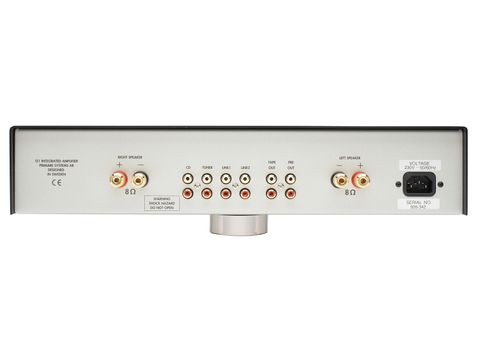TechRadar Verdict
Great design considering the price but a frustratingly mixed bag performance-wise
Pros
- +
Good looks
- +
Excels in midrange and treble
Cons
- -
Average imaging
- -
Lacks low-frequency subtlety
Why you can trust TechRadar
Considering its price, this amp is very high-end in appearance. Primare has the knack of classy visual design, and it's all so efficiently done, too - a plain steel tray for the base, back and sides, with an aluminium front panel added and a distinctive volume knob plus selector buttons, all in stainless steel. The review sample was black, but titanium is also available.
The I21 is heavy, due partly to the case but also to the large mains toroidal transformer that dominates under the lid. There's a fair amount of space inside, though, as Primare's use of surface-mount technology has ensured that the audio circuit board is small. It is neatly sandwiched between the internal heatsinks and the back panel, and all the input and output sockets are mounted directly on the board, eliminating excess wiring and doubtless helping keep costs down, too.
In the interests of channel independence, Primare has opted for 'dual-mono' construction. Each channel has its own transformer winding, as well as rectifier and smoothing capacitors, though a few components are shared, including the electronic volume control. Input switching is also electronic. The output transistors are fast bipolar types, one pair per channel, while the voltage amplifying stages use a typical mix of op-amps and bipolar devices.
Primare may have gone a little too minimalist for some in providing only four line-level inputs (no phono option) and there's just one set of speaker terminals, but you do at least get a preamp output in case you want to bi-amp or upgrade to an external power amplifier.
This proved to be an amplifier with a performance that is dependent on the style of music one happens to be playing. In this case, the variable is the bass, which seems to be more confident in big-scale music than in quieter stuff. In the opening track of our blind listening sequence, Michael Jackson's backing seemed over-rich in bass, though it was well controlled. Later tracks required more subtle bass and seemed lean by contrast.
Timing seems to follow the bass, as it were, making for a lively and energetic experience with rock, but a less toe-tapping time with gentler music. But if that sounds dismissive, it shouldn't overshadow this amp's undoubted abilities in midband and treble tonality and detail.
It is very good at distinguishing between lead and backing vocals, for instance, or between different instruments in an ensemble. Our listeners found it particularly good at reproducing string instruments including massed orchestral violins, a difficult sound to get right but here replayed without any of the glassiness that can often plague it.
Imaging was found a little lacking here, with some constriction to the width and not quite the precision in placement fore and aft that some of the amps managed. Dynamics are good, with a fine sense of sweep to the ebb and flow of large-scale works particularly.
Overall, we found this amp a little uninvolving; pleasant enough but neither as beguiling nor as analytical as others. As such, we feel this is not the jewel in Primare's (generally very impressive) crown.
Tech.co.uk was the former name of TechRadar.com. Its staff were at the forefront of the digital publishing revolution, and spearheaded the move to bring consumer technology journalism to its natural home – online. Many of the current TechRadar staff started life a Tech.co.uk staff writer, covering everything from the emerging smartphone market to the evolving market of personal computers. Think of it as the building blocks of the TechRadar you love today.

